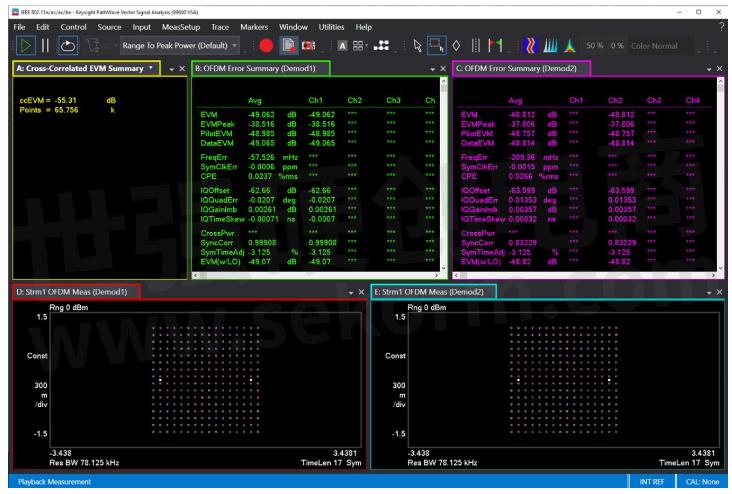Wi-Fi 7 Signal Analysis and Testing Software

The performance of wireless solutions is improving but meeting regulatory standards is becoming a challenge if not prepared correctly. In order to perform at a high capacity, we need to ensure we are testing with high-performance products that can meet new standards and regulations. For Wi-Fi 7 this is no different as we first must understand what is new to the standard, the wireless signal challenges these new rules impose, and what type of test software would assist in resolving those challenges.
History of 802.11 and what is new to 802.11be
WLAN products and systems started with 802.11b, 802.11g, and 802.11a standards, all of which provided throughput enhancements over the original 802.11 standards introduced in 1997. To meet the requirements of new applications and the need for higher data rates, wireless technology continues to evolve by integrating the latest technologies. The goal is clear: to continuously improve spectrum utilization, throughput, and user experience.
The current WLAN standard, 802.11ax, is an evolutionary improvement to 802.11ac. It adds a significantly higher efficiency, capacity, and coverage for a better user experience, especially for dense deployment scenarios in both indoor and outdoor environments (e.g., stadiums, airports, and shopping malls). Unlike 802.11ac, 802.11ax operates in 2.4, 5, and 6-GHz bands and employs technology building blocks like Orthogonal Frequency Division Multiple Access (OFDMA) for high efficiency, 8x8 Multi-User MIMO (MU-MIMO) for high capacity, and uplink scheduling for increased capacity, efficiency, and better user experiences. Other technologies, such as 1024-QAM modulation, improve throughput.
While in the early development stage, the next generation 802.11 standard, 802.11be holds great promises. A lot of new features will significantly increase throughput and provide support for real-time applications. These features include 320 MHz transmission bandwidth, use of 4096-QAM modulation, and enhancements to MIMO with more spatial streams. Like 802.11ax, 802.11be will also operate in 2.4, 5, and 6 GHz frequency bands.
New WLAN devices will require to be backward compatible and coexist with legacy IEEE 802.11devices operating in the same band. Table 1 compares key physical layer (PHY) technologies of 802.11n, ac, ax, and be.

Table 1. Key PHY comparison of 802.11n, 802.11ac, 802.11ax, and 802.11be
How PathWave Software can help you test 802.11 signals
Designers can now gain an advantage on the latest wireless signals with Keysight's PathWave Vectory Signal Anlysis (89600 VSA) software for 802.11n/ac/ax, and 802.11be modulation analysis. Software options provide an advanced troubleshooting and evaluation toolset specifically designed to handle the challenge of analyzing legacy and new wireless signals, covering technologies such as MU-MIMO and OFDMA used in the latest standards. 802.11 standards are among over 75 signal standards and modulation types that PathWave 89600 can support.
Phase noise is often the dominant cause of EVM issues in OFDM systems. Vector signal analysis software allows us to characterize phase noise within the 802.11be demodulation measurement. Using an OFDM channel called phase noise spectrum trace. This helps tremendously evaluate the signal quality and error vector measurements of transmitted signals. PathWave VSA software also allows us to record error vector spectrum, error vector time, common pilot error, channel frequency response, and more, for all wireless standard formats.
PathWave VSA is also enabling more advanced testing features such as Cross-Correlated EVM (ccEVM) to improve EVM performance. ccEVM is a technique used to extend the dynamic range of a receiver for the best EVM performance. Using two receivers to capture and demodulate the same signal independently and perform cross-correlation on the error vectors to cancel out uncorrelated noise added by the receivers, resulting in a much lower EVM. This technique causes the ccEVM value to primarily contain just the noise coming from the device under test or in the case of an amplifier noise coming from the signal source plus the device under test.
In Figure 1, we can see an example of how the software uses ccEVM. In this example, engineers use a signal generator and two receivers along with ccEVM to result in a 6 dB EVM improvement of the 802.11be WLAN signal.

Figure 1. Cross-correlated EVM results (Box A) compared with EVM results of the individual receiver (Box B and C).
Conclusion
We can continue to go through all the features that software brings to a wireless connectivity testing world, but it would take too long and we would always end with the same result. Software is critical in helping us test standards such as Wi-Fi 7 but also any newly released wireless standard. We need to use high-performance solutions to enable easier testing and evaluation that our wireless devices are meeting regulations. The software enables us to analyze, test, and resolve critical issues in wireless connectivity.
- +1 Like
- Add to Favorites
Recommend
This document is provided by Sekorm Platform for VIP exclusive service. The copyright is owned by Sekorm. Without authorization, any medias, websites or individual are not allowed to reprint. When authorizing the reprint, the link of www.sekorm.com must be indicated.
























































































































































































































































































































































































































































































































































































































































































































































































































































































































